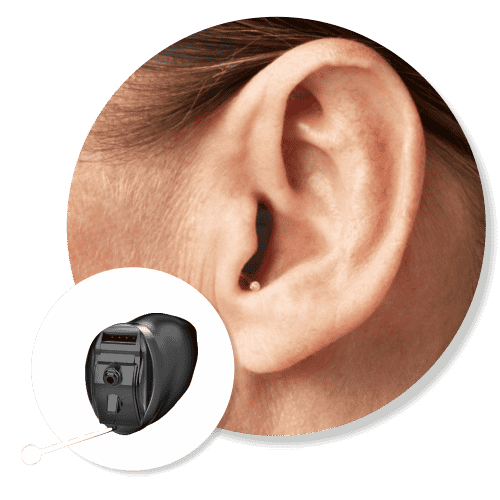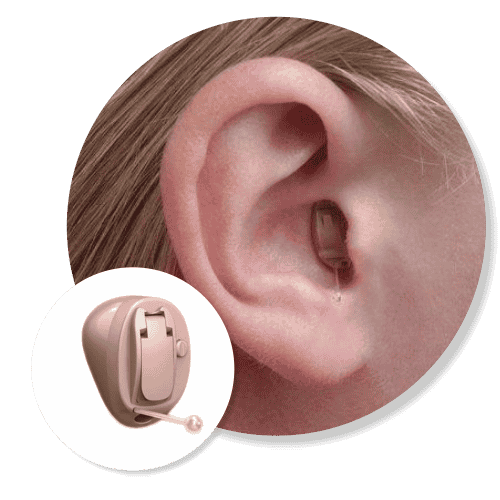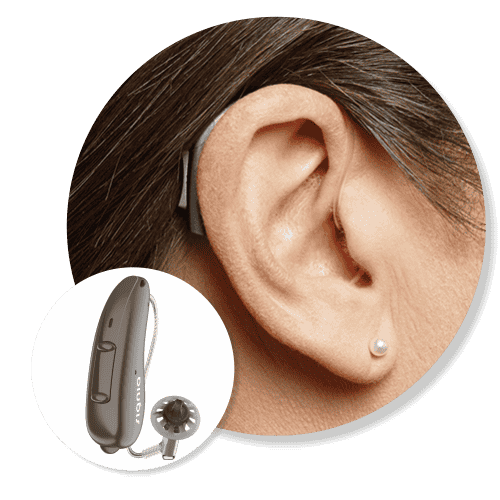HEARING AIDS
type of hearing aids

Invisible In the Canal (IIC)
Nearly invisible and fully automatic, IIC offers a natural hearing experience.

Completely In the Canal (CIC)
A discreet, deep-fit hearing aid designed for mild to moderate hearing loss.

Receiver In Canal (RIC)
A small, advanced device with a separate speaker for clearer sound.

Behind the Ear (BTE)
A powerful hearing aid ideal for severe hearing loss and small ear canals.
DIGITAL HEARING AIDS
Step into the Future with Digital Hearing Aids – Welcome to Crystal Hearing Solutions
What Are Digital Hearing Aids?
Why Choose Digital Over Analog?
- Distinguish speech from noise for clearer conversations
- Adjust automatically to different environments
- Offer customizable settings for a truly personal experience
- Enhance sound quality for a more natural listening experience
How Do Digital Hearing Aids Work?
- Reduce background noise so you can focus on what matters
- Adjust to different environments automatically
- Enhance speech clarity for effortless conversations
- Sync with smartphones, TVs, and more for a seamless experience
The Life-Changing Benefits of Digital Hearing Aids
- You engage effortlessly in conversations, even in noisy settings
- You enjoy crystal-clear music and phone calls streamed directly to your ears
- You control your hearing discreetly through your smartphone
- You feel more connected to your loved ones and surroundings
Experience the Crystal Clear Difference
At Crystal Hearing Solutions, we believe hearing loss should never hold you back. Our state-of-the-art digital hearing aids bring you a comfortable, natural, and smart listening experience—so you can enjoy life without limitations.
INVISIBLE HEARING AIDS
What Are Invisible Hearing Aids?
Hearing aid technology has evolved tremendously from the bulky, noticeable devices of the past. Today, invisible hearing aids offer a seamless, discreet, and highly effective solution for those who want to enhance their hearing without drawing attention to their device.
Unlike traditional hearing aids, invisible hearing aids are custom-fit to sit deep within your ear canal, making them virtually undetectable to others while delivering crystal-clear, natural sound. You’ll hear the difference—but no one else will see it!
Invisible-in-Canal (IIC) vs. Other Discreet Hearing Aids
Why Choose Invisible Hearing Aids?
- Ultra-Discreet: Virtually undetectable to others
- Powerful & Smart: Advanced sound processing for natural hearing
- Lightweight & Comfortable: Designed for all-day wear
- Custom-Fit: Tailored to match your unique ear shape
- Reduced Wind & Background Noise: Less interference from unwanted sounds
- Suitable for Mild to Severe Hearing Loss: A solution for every need
- Custom-made to fit perfectly in your ear canal
- Practically undetectable, offering ultimate discretion
- Ideal for mild-to-moderate hearing loss
- Tiny and lightweight with a barely visible behind-the-ear component
- Offers clear and natural sound
- Ideal for various levels of hearing loss
- Small and designed for high-power performance
- Ideal for severe-to-profound hearing loss
- Available in multiple sizes and colors for personal preference
Rediscover Clear, Confident Hearing
BLUETOOTH HEARING AIDS
What is Bluetooth?
- Stream calls, music, and TV audio directly into your ears
- Pair with multiple devices like smartphones, tablets, and computers
- Enjoy hands-free conversations without lifting a phone to your ear
- Experience crystal-clear sound tailored to your hearing needs
How Bluetooth Hearing Aids Work
- Made for iPhone (MFi) Hearing Aids – Designed specifically for Apple devices, these hearing aids connect directly to iPhones, iPads, and iPods for instant audio streaming.
- Bluetooth Hearing Aids for Android™ – Compatible with Android devices, these hearing aids connect either directly or via a small wireless streamer, allowing you to enjoy the same effortless connectivity.
- TV & Multi-Device Streaming – With Bluetooth-enabled hearing aids, you can link multiple devices at once. Whether it’s your TV, music system, or laptop, your hearing aids become your personalized, high-definition audio system.
Why Choose Bluetooth Hearing Aids?
- Ultimate Convenience – No more struggling to hear phone calls or TV audio
- Superior Sound Quality – Direct streaming for crystal-clear hearing
- Customizable & Adaptive – Adjust settings for a personalized experience
- Seamless Connectivity – Connect to multiple devices effortlessly
- Discreet & Modern – Smart technology in a sleek, nearly invisible design
Hear Smarter, Live Better
At Crystal Hearing Solutions, we bring you the latest in Bluetooth hearing technology to keep you connected to the people and moments that matter most.
RECHARGEABLE HEARING AIDS
How Do Rechargeable Hearing Aids Work?
- Quick & Easy Charging – Place your hearing aids in the charger, and they start charging instantly
- All-Day Power – A full charge lasts up to 30 hours, even with audio streaming
- No More Battery Hassles – No tiny batteries to replace or carry around
- Eco-Friendly – Reduce waste from disposable batteries
Why Choose Rechargeable Hearing Aids?
- Ultimate Convenience – No more struggling with battery replacements
- Reliable & Long-Lasting Power – Stay connected all day with a single charge
- Smart & Modern – Seamlessly integrates with your digital lifestyle
- Discreet & Comfortable – Lightweight, compact, and custom-fit to your needs
- Better for the Environment – No more disposable batteries ending up in landfills
Advanced Technology for a Seamless Experience
- Bluetooth Connectivity – Stream calls, music, and TV audio directly to your hearing aids
- Smart App Control – Adjust settings and monitor battery life from your phone
- Portable Charging Case – Take power on the go, with up to three full charges stored in the case
Are Rechargeable Hearing Aids Right for You?
Power Up Your Hearing. Stay Connected.
BATTERY OPERATED HEARING AIDS
Why Choose Battery-Operated Hearing Aids?
- Stream calls, music, and TV audio directly into your ears
- Pair with multiple devices like smartphones, tablets, and computers
- Enjoy hands-free conversations without lifting a phone to your ear
- Experience crystal-clear sound tailored to your hearing needs
Key Benefits of Battery-Operated Hearing Aids
- Budget-Friendly – A great option for those looking for an affordable hearing aid solution
- Easy to Maintain – Batteries are widely available and simple to replace
- Lightweight & Portable – Small, compact batteries are easy to carry and swap whenever needed
- Instant Power – No need to wait for charging—just insert a new battery, and you're good to go
- Backup Ready – Always keep spare batteries on hand for uninterrupted hearing


